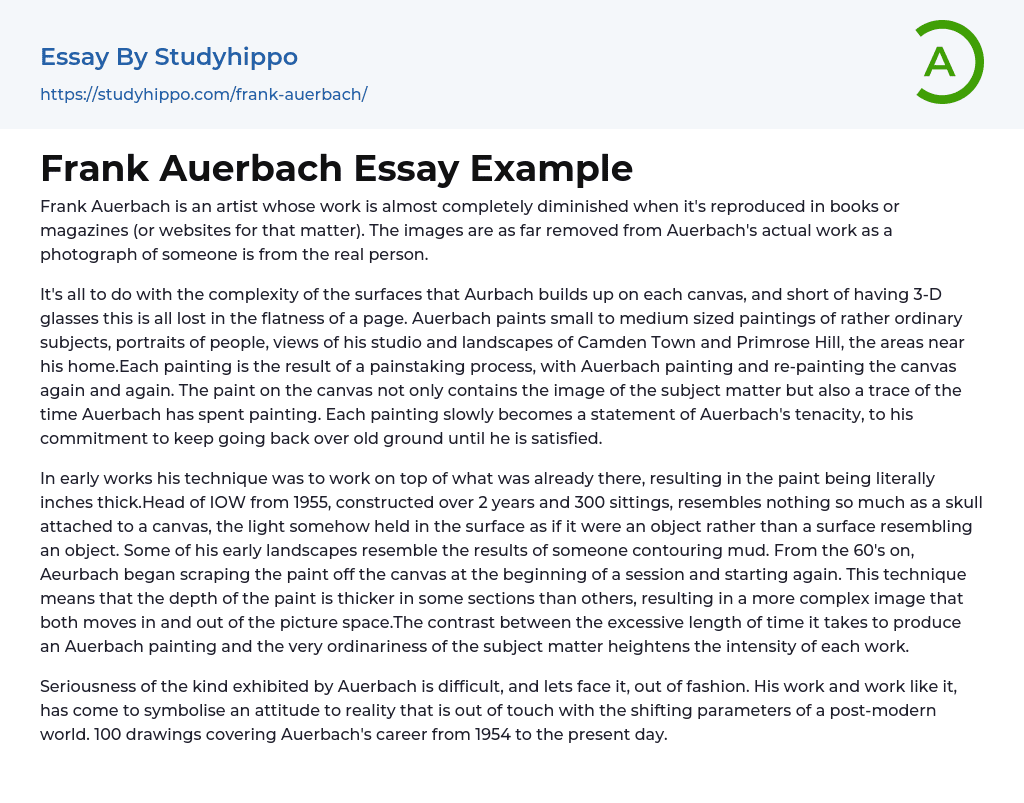Frank Auerbach is an artist whose work is almost completely diminished when it's reproduced in books or magazines (or websites for that matter). The images are as far removed from Auerbach's actual work as a photograph of someone is from the real person.
It's all to do with the complexity of the surfaces that Aurbach builds up on each canvas, and short of having 3-D glasses this is all lost in the flatness of a page. Auerbach paints small to medium sized paintings of rather ordinary subjects, portraits of people, views of his studio and landscapes of Camden Town and Primrose Hill, the areas near his home.Each painting is the result of a painstaking process, with Auerbach painting and re-painting the canvas again and again. The paint on the canvas not only contains the image of th
...e subject matter but also a trace of the time Auerbach has spent painting. Each painting slowly becomes a statement of Auerbach's tenacity, to his commitment to keep going back over old ground until he is satisfied.
In early works his technique was to work on top of what was already there, resulting in the paint being literally inches thick.Head of IOW from 1955, constructed over 2 years and 300 sittings, resembles nothing so much as a skull attached to a canvas, the light somehow held in the surface as if it were an object rather than a surface resembling an object. Some of his early landscapes resemble the results of someone contouring mud. From the 60's on, Aeurbach began scraping the paint off the canvas at the beginning of a session and starting again. This technique means that
the depth of the paint is thicker in some sections than others, resulting in a more complex image that both moves in and out of the picture space.The contrast between the excessive length of time it takes to produce an Auerbach painting and the very ordinariness of the subject matter heightens the intensity of each work.
Seriousness of the kind exhibited by Auerbach is difficult, and lets face it, out of fashion. His work and work like it, has come to symbolise an attitude to reality that is out of touch with the shifting parameters of a post-modern world. 100 drawings covering Auerbach's career from 1954 to the present day.
- Pablo Picasso essays
- Vincent Van Gogh essays
- Michelangelo essays
- Frida Kahlo essays
- Aesthetics essays
- Art History essays
- Artist essays
- ballet essays
- Body Art essays
- Color essays
- Concert Review essays
- Creativity essays
- Cultural Anthropology essays
- Ethnography essays
- Harlem Renaissance essays
- Heritage essays
- Modernism essays
- Mona Lisa essays
- Pastoral essays
- Postmodernism essays
- Realism essays
- Symbolism essays
- Theatre essays
- Visual Arts essays
- Voice essays
- Work of art essays
- Architecture essays
- Design essays
- Graffiti essays
- Graphic essays
- Interior design essays
- Painting essays
- Photography essays
- Sculpture essays
- Typography essays
- The real essays




